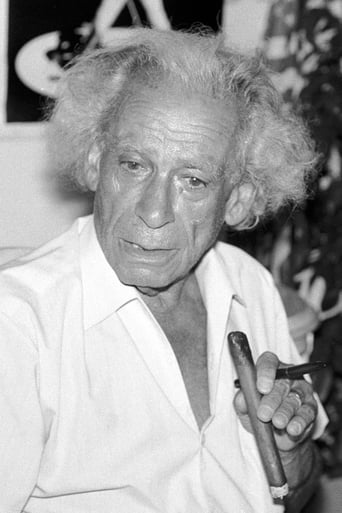FeistyUpper
If you don't like this, we can't be friends.
Claysaba
Excellent, Without a doubt!!
Senteur
As somebody who had not heard any of this before, it became a curious phenomenon to sit and watch a film and slowly have the realities begin to click into place.
Kaydan Christian
A terrific literary drama and character piece that shows how the process of creating art can be seen differently by those doing it and those looking at it from the outside.
Christopher Culver
In the early 1950s, 20th Century Fox invited Samuel Fuller to make a picture in Brazil about a jaguar hunter (John Wayne was tipped for the role) falling in love with a woman (Ava Gardner) he helps to rescue as she flees through the jungle with her cowardly husband. Fuller headed for Brazil to make a preliminary study and settled in a village of the indigenous Karaja tribe. He scouted locations, shot some footage of local nature and customs, and discovered some elements that he might work into the screenplay. In the end, however, the whole project came to naught when insurance companies refused to provide coverage for a shoot in what was then a remote and potentially dangerous part of the world.In Mika Kaurismäki's 1992 documentary, TIGRERO: A Film that was Never Made, Sam Fuller returns to the same village he based himself in four decades before. American indie filmmaker Jim Jarmusch tags along as the interlocutor to which Fuller recounts the whole Hollywood story and comments on how rural Brazil has changed since his first visit. Jarmusch is also interested in the culture of the Karaja, taking photographs of the village (some of which are included as extras in the DVD release) and narrating in voice-over some of their traditions and practices. The downside of this is that the duo talk about the Karaja according to the noble savage stereotype, depicting them as an idyllic people without a care in the world, and the film never confronts the challenges they might have faced now as modernity arrives, or forty years ago when life was no bed of roses either.The film has an inauspicious beginning, where Jarmusch asks Fuller in Rio de Janeiro why he's there, and it's obvious that this whole (very stilted) dialogue is scripted. Once they subsequently reach the Karaja village, their chats seem more real. The first thing they do in the village is project the footage that Fuller he had shot forty years before to the locals. The Karaja are amazed to see their long-dead relatives and friends. As one Karaja explains the visceral impact that this film footage had on him, Fuller tells him "That's called emotion," the same cinematic creed he professed in his cameo role in Godard's Pierrot Le Fou.Fuller is a funny character. He was already around 80, a wizened old man that seems only about half the height of Jarmusch, but he's full of energy and enthusiasm for this adventure. He appears almost invariably with a cigar in his mouth and a baseball cap and talks in this really old-timey New York Jewish accent. I honestly found him hard to understand at points, it's like watching someone speaking Elizabethan English step out into the world of 1992.TIGRERO doesn't seem a major achievement in documentary filmmaking, and after one viewing I don't feel in a hurry to ever see it again. Nonetheless, it was an enjoyable 75 minutes and I appreciated learning something about this part of the world.
danmusikat
The image of hipster Jarmusch and Old-School Fuller wandering around like 2 characters in search of an epiphany was wacky enough. Place them in the middle of a Karaja village, with the amazing back-story of Fuller's flirtation with a jungle epic-that-never-was, and you've got a great little documentary that surpasses expectations--if in fact you had any. It's true that Jarmusch is absurdly out of place here, but that only ads to the surrealistic bent of the thing. And Fuller, a physical midget next to Jarmusch, is the one who is truly larger than life; a throwback to a time when directors truly dreamed and took action--the sort of character that Hollywood, in its increasing dependence on CGI, has conveniently squelched. We get to see a maverick, a dreamer, an egotist and a great observer of life in its myriad forms, who clearly loved every second of his time on this earth. The film is somewhat hampered by a lack of what a script man would call structure. And yet that didn't bother me because it was like watching a human circus unfolding: Here a Karaja ritual; there, Fuller fulminating about what coulda been, and everywhere around the amazing Mato Grosso, the real star of the story. Okay, it's no Aguirre, but if you love the process of film in its purest form, this is a terrific little flick.
FilmCriticLalitRao
It is true that offbeat documentary film "Tigrero: A Film That Was Never Made" has its own intrinsic star value featuring maverick American independent cinema artists Samuel Fuller and Jim Jarmusch but the real stars of this charming film within a film tale are "The Karaja",native people from Brazil.In many ways this documentary by Finnish cinema author Mika Kaurismaki is an amazing journey into heart, minds and souls of Karaja people who teach viewers a humble lesson of humanity.We get to learn that even though they are close to human civilization,it is normal for them to maintain their distance from modern people.This is a unique quality which has found many admirers especially people like Samuel Fuller and Jim Jarmusch who make good friends with Karaja people."Tigrero: A Film That Was Never Made" is also a film with serious purpose as its protagonists arrive in style to explore new facets in film making.Each of them have their own agendas: Jim Jarmusch with his ubiquitous video camera and Samuel Fuller with his charming cigar.As Mika Kaurismaki has made a film oozing with emotional attachment related to true love for cinema,one has to really feel the sadness with which Samuel Fuller narrates how his unfinished film "Tigrero" with big names of Hollywood cinema John Wayne,Ava Gardner and Tyrone Power could not be made due to malicious attitude of American insurance companies.One has to pay attention to each word uttered by Samuel Fuller,a legendary director whose genius could not be appreciated by many in Hollywood.It is true that Samuel Fuller's widow Christa Lang gave the idea for making "Tigrero: A Film That Was Never Made" but Mika Kaurosmakin must be congratulated for making a great film as his approach is humanist in nature as his film is an honest vision of a genius who should have been properly recognized by Hollywood and American film industry.
jon-510
I somewhat agree with the comments about the scripted components, but I don't think they really do any damage to the film.This docco has a lot of range, its tear jerkingly poignant in places, downright hilarious in others, and just astounding in others. The chief witchdoctors doing their elaborate ritual, fainly chanting 'Hollywood... Hollywood...' is a really transporting moment.The film definitely causes one to wonder about the future of the natives, whether they will go on as they have in their idyllic little universe.Strange thing is - I'm not actually that much of a Jim Jarmusch fan (yes I know he didn't direct this film but he would have had a lot of input), except for Dead Man which is a masterpiece. But this is a little gem.I recommend this film, its cute and beautiful.


